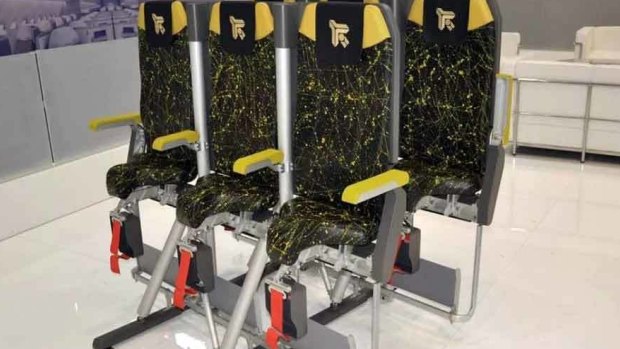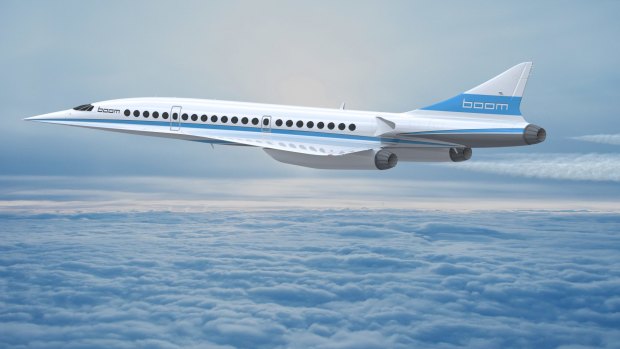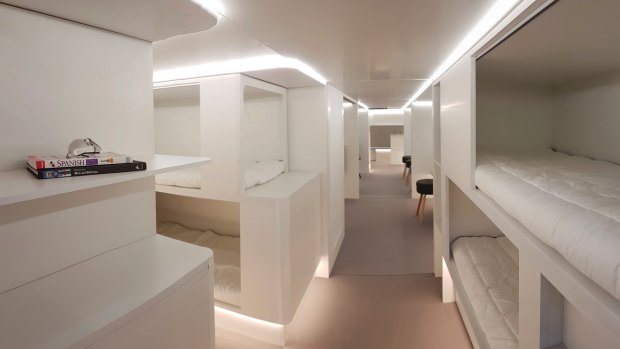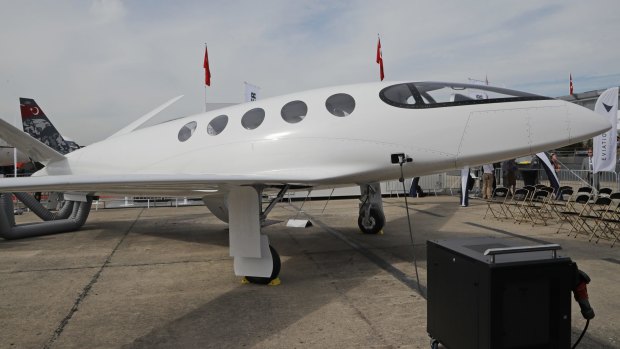This was published 4 years ago
Future air travel concepts: Standing seats, supersonic airlines and more ideas that will never fly
Ever heard of the detachable aircraft cabin? The one with a complete passenger module that filled up at the terminal and then got dropped into place on the aircraft, slashing turnaround time? Or how about the stackable cabin design that proposed hoisting some passengers above others to make use of all that empty overhead space?
Just a couple of the weird ideas that never made it off the drawing board. Designers, airline revenue managers and aeronautical engineers are constantly tinkering, sometimes for better, but there are some ideas that should never get airborne.
Saddle seats

Airlines are continually looking for new ways to squeeze more bums on seats since that equals more revenue and the showcase for these high-capacity seating concepts is Hamburg's annual Airline Interiors Expo.
One of the present favourites is Aviointeriors Skyrider 3.0 (above), which has a polyester saddle-style seat in eye-catching canary yellow and black with minimal padding that sits the passenger bolt upright and with zero recline.
The real crunch though is the seat pitch – a mere 58.4 centimetres – ouch! That's 15.2 centimetres less than the current seat pitch on the very meanest of the low-cost carriers. Tray table? You must be joking.
Worse still are bicycle seats – back-free butt biters that promise to ramp up the agony factor to excruciating new levels. And better pray there's no turbulence, chaps. One reason that these ultra-squeezy seats have failed to gain traction with airlines is commercial aircraft certification requirements.
As a condition of certification, aircraft must be capable of being completely evacuated within 90 seconds. Without increasing the number of emergency exits, which sacrifices seats, there's a limit to the number of bodies you can stack inside an aircraft cabin and comply with that evacuation requirement.
See also: 'Torture chamber': New design for standing seats on planes
Extra charges for overweight passengers
More weight equals more fuel burned, and airlines would love to be able to levy a charge on overweight passengers but for the fact they'd be crucified on social media and spend a fortune on lawyers defending anti-discrimination lawsuits.
Back in 2013 Samoa Air introduced such a charge, and with good reason since the people of Samoa are spectacularly well fleshed. Nine out of 10 of its people are overweight. Meanwhile, the late Tongan King Tupou IV, who died in 2006, weighed in at a whopping 200 kilograms. Samoa Air faded from view in 2015 and its successor, Samoa Airways, never adopted the practice. So there's fat chance any others will.
Supersonic commercial aircraft

Faster flights – what's not to love about that? Especially for Australians. We'd all love to fly from Sydney or Melbourne to west coast US in less than seven hours, or to Europe in under 12, but there are reasons why that's never likely to happen. Due to the sonic boom that happens when an aircraft travels faster than the speed of sound, commercial aircraft are banned from flying at supersonic speeds over North America and Europe.
Unless they can fly over those two continents it's unlikely that major manufacturers would be tempted to develop a full-size commercial supersonic aircraft. That's not to say it won't happen. Several manufacturers are working to develop aircraft with a less pronounced sonic footprint but it's most likely that those will be smaller business jets, such as the Overture jet that Boom Technologies is developing or the Lockheed Martin X-59 QueSST.
See also: How new supersonic jets will deal with their one big problem
Sleeper compartments for economy passengers

Credit: Airbus
This teaser was unleashed at the 2018 Aircraft Interiors Expo held in mid-April in Hamburg, when seat manufacturer Zodiac Aerospace announced plans to develop a passenger sleeping module fitted inside the cargo hold of Airbus' A330 and A350 family aircraft.
The mock-up looked wonderful – a spacious central corridor with sleeping compartments and lounge areas running off. Perfect for those ultra-long non-stop flights Qantas is planning from east coast Australia to New York and London, but not to be.
Qantas chief executive Alan Joyce has dismissed the idea, and why wouldn't he? Airlines are constantly looking for ways to shove more passengers into the available space, why go in the opposite direction?
Remember those economy-class lounges that graced some airlines' early model Boeing 747s? American Airlines' 747s even had an economy-class piano bar. Sacrificed so that airlines could get a few more paying bodies on board. Shortest lifespan ever.
See also: Qantas drops plans for bunk beds, gym for ultra long-haul flights
Pay-for-use toilets
This idea was floated back in 2009 when Ryanair boss Michael O'Leary announced the airline would be charging £1 or €1 for passengers to use the loo. Flying with the world's most despised carrier, and yet the one that totes more passengers across international borders than any other, you quickly realise there is no bottom to the depths of humiliation and discomfort that Ryanair is prepared to inflict on its passengers.
The backlash was swift and the idea was quickly flushed. The attraction was not so much the revenue gain from toilet use as the extra room for seats. O'Leary reasoned that fewer passengers would be inclined to spend a penny and therefore Ryanair could dispense with two toilets and install another six seats. Ryanair planes usually make do with just three toilets. That would bring toilet facilities down to one per plane, which might just make self-cleaning aircraft seats a goer.
And two ideas that probably will take off ...
Electric engine aircraft

Credit: AP
Electric engines are already lifting small, light aircraft aloft. At the present rate of progress you can expect to see short-haul flights aboard aircraft powered by electric engines in the next few years.
At the recent Paris Air Show, Israeli firm Eviation showed off an electric-powered propeller aircraft (above) that Eviation claimed will carry nine passengers for just over 1000 kilometres at 440km/h. The aircraft is expected to enter service in 2022.
Window-free aircraft
Aircraft without windows are lighter and cheaper to build. They also reduce drag and reinforce the airframe, since windows are a structural weakness. Windows can even rupture, with catastrophic outcomes, so why not ditch them?
That's the reasoning of Emirates, which has unveiled a mocked-up first-class cabin with digital screens that display what's happening outside in place of windows.
No windows might be a bridge too far for some passengers but given that most commuters and many urban pedestrians prefer their digital screen over what's happening around them, most will murmur and adapt.
See also: Revealed: The world's safest, and least safe, planes to fly on
Sign up for the Traveller newsletter
The latest travel news, tips and inspiration delivered to your inbox. Sign up now.